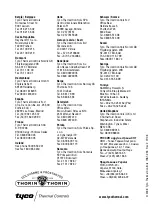
10
ENGLISH
FrostGuard, self-regulating heating cable for
anti-freeze protection of water pipes.
IP 68. Application conditions min. –30°C and
max. +65°C
Instructions for installation
FrostGuard
is supplied with 2 m of power cable
and a plug for temporary installation. The cable
is non replaceable and the entire heating cable
must be discarded if it is damaged.
CAUTION: Make sure that the heating cable is
not covered by material with heat resistance
less than +65°C. For permanent use, contact
your electrical contractors for permanent
installation in a box and with a thermostat.
Use a 30-mA GLCB or RCD. Tyco Thermal
Controls, international and local electrical
codes, and standards all require the use of a
ground-fault equipment protection device on
each heating cable circuit. Arcing may not be
stopped by conventional circuit breakers which
could result in a fire hazard.
External installation
1a.
Tape the heating cable to the underside of
the pipe. Use age-resistant tape, e.g. elec-
trical tape.
2a.
Insulate the pipe. Select the insulation
thickness according to the table.
3a.
Connect to a wall socket.
Internal installation
1b.
Fit the Y-piece to the pipe. Thread the
R20-connector onto the heating cable. Use
a lubricant, such as washing up liquid, to
facilitate application of the rubber packing.
Insert the heating cable into the Y-piece.
The splice
between the heating cable and cold cable
must not be inserted in the pipe.
2b.
Fully tighten the R20 connector.
3b.
Insulate the pipe. Select the insulation
thickness according to the table.
DEUTSCH
FrostGuard, ein selbstregelndes Heizband
zum Frostschutz an Wasserleitungen. IP 68.
Anwendungsbereich: Min. –30°C und max.
65°C.
Montageanleitung
FrostGuard
ist mit einem 2 m langen
Anschlusskabel und Schuko-Stecker ver-
sehen. Das Anschlusskabel kann im Falle
einer Beschädigung nicht ersetzt werden.
Es muss das komplette Heizband inklu-
sive Anschlussleitung ausgetauscht wer-
den. Frostguard ist für vorübergehende
Anwendungen konzepiert.
WARNUNG: Stellen Sie sicher, dass das
Heizband nur mit Material abgedeckt/isoliert
wird, dass mind65°C temperaturbe-
ständig ist. Für eine permanente Installation
sollten Sie einen Elektriker kontaktieren um
einen festen Anschluss und ein Thermostat
installieren zu lassen.
Der Einsatz eines 30-mA FI-Schutzschalters ist
vorgeschrieben. Tyco Thermal Controls, inter-
nationale und lokale Normen und Vorschriften
der Elektrotechnik, fordern den Einsatz eines
FI-Schutzschalters für jeden Heizkreis. Der
Einsatz von Sicherungsautomaten allein kann
sich als nicht ausreichend erweisen, um das
Fortschreiten von Lichtbögen zu verhindern;
dadurch kann Brandgefahr entstehen.
Installation auf der Rohrleitung
1a.
Befestigen Sie das Heizband mit Klebeband
alle 30 cm an der Unterseite des Rohres.
2a.
Isolieren Sie das Rohr und selektieren Sie
die Dämmstärke gemäß Tabelle.
3a.
Schließen Sie das Heizband über eine
Steckdose an AC 230 V Netzspannung an.
Installation in der Rohrleitung
1b.
Installieren Sie die Y-Kupplung an der
Rohrleitung. Schieben Sie die R20-
Verschraubung über das Heizband.
Benutzen Sie Spühlmittel um die
Gummidichtung leichter schieben zu kön-
nen. Schieben Sie nun das




































